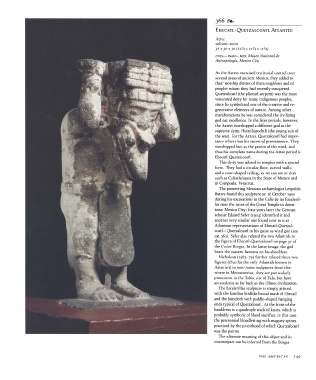Page 550 - Art In The Age Of Exploration (Great Section on Chinese Art Ming Dynasty)
P. 550
366
EHECATL-QUETZALCOATL ATLANTID
Aztec
volcanic stone
3
58 X }0 X 30 (22% X H /4 X 11 /4J
3
CNCA—INAH—MEX, Museo National de
Antropologia, Mexico City
As the Aztecs exercised territorial control over
several areas of ancient Mexico, they added to
their worship deities of their* neighbors and of
peoples whom they had recently conquered.
Quetzalcoatl (the plumed serpent) was the most
venerated deity for many indigenous peoples,
since he symbolized one of the creative and re-
generative elements of nature. Among other
manifestations he was considered the civilizing
god par excellence. In the later periods, however,
the Aztecs worshipped a different god as the
supreme deity, Huitzilopochtli (the young sun of
the war). For the Aztecs, Quetzalcoatl had impor-
tance other than his ancestral preeminence. They
worshipped him as the patron of the wind, and
thus his complete name during the Aztec period is
Ehecatl-Quetzalcoatl.
This deity was adored in temples with a special
form. They had a circular floor, curved walls,
and a cone-shaped ceiling, as we can see in sites
such as Calixtlahuaca in the State of Mexico and
in Cempoala, Veracruz.
The pioneering Mexican archaeologist Leopoldo
Batres found this sculpture on 16 October 1900
during his excavations in the Calle de las Escaleril-
las near the ruins of the Great Temple in down-
town Mexico City; four years later the German
scholar Eduard Seler (1904) identified it and
another very similar one found next to it as
Atlantean representations of Ehecatl-Quetzal-
coatl — Quetzalcoatl in his guise as wind god (see
cat. 363). Seler also related the two Atlantids to
the figure of Ehecatl-Quetzalcoatl on page 51 of
the Codex Borgia. In the latter image, the god
bears the eastern heavens on his shoulders.
Nicholson (1983, 79) further related these two
figures (thus far the only Atlantids known in
Aztec art) to non-Aztec sculptures from else-
where in Mesoamerica; they are particularly
prominent in the Toltec site of Tula, but have
antecedents as far back as the Olmec civilization.
The Escalerillas sculpture is simply attired,
with the familiar birdlike buccal mask of Ehecatl
and the loincloth with paddle-shaped hanging
ends typical of Quetzalcoatl. At the front of the
headdress is a quadruple stack of knots, which is
probably symbolic of blood sacrifice, in this case
the penitential bloodletting with maguey spines
practiced by the priesthood of which Quetzalcoatl
was the patron.
The ultimate meaning of this object and its
counterpart can be inferred from the Borgia
THE AMERICAS 549

